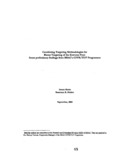| dc.identifier.citation | Matin, I., & Halder, S. R. (2002, September). Combining targeting methodologies for better targeting of the extreme poor: some preliminary findings from BRAC's CFPR/TUP programme. Research Reports (2002): Economic Studies, Vol - XVIII, 65–95. | en_US |
| dc.description.abstract | Since January 2002, BRAC has started a new program targeted at the extreme poor, called,
'Challenging the Frontiers of Poverty Reduction: Targeting the Ultra Poor' (CFPR/TUP). This
Programme seeks to challenge the frontiers of poverty reduction by addressing two key
limitations of much poverty reduction interventions to date. First, the Programme seeks to 'push
down' the reach of development programmes through specific targeting of the ultra poor who
have suffered relative neglect in most development programme interventions to date. Secondly,
it seeks to 'push out' the domain within which existing approaches operate, by addressing
dimensions of poverty that many conventional approaches fail to address. Specifically, this
involves a shift away from the conventional service delivery mode of development programming
to focussing on human capital, and the structures and processes that disempower the poor,
especially women, and constraint their livelihood. It is an approach that puts social development,
specifically a rights-based approach to health and socio-political empowerment, at the heart of
the agenda. This paper has two objectives. The first is an introduction of the new BRAC Programme that
aims to experiment with a different type of approach to attacking extreme poverty. More
specifically, the focus in this paper is to introduce the targeting methodology used in this
Programme. The underlying theme of both the CFPR/TUP Programme and the targeting
methodology it used is an acknowledgment of the power and strength of combining methods
and approaches and thereby leveraging each other. The Programme for instance combines
promotion and protection oriented mechanisms to attacking poverty and uses this mix at various
levels acknowledging the idea that the structures that create and reproduce poverty work at
multiple levels. Similarly, the targeting approach used in the Programme also combines various
targeting methodologies and knowledge streams about who the extreme poor are and where they
live. The second objective of this paper is to use Programme data emerging out of the targeting
exercise to undertake preliminary exploration of questions of effectiveness of the approach used. The combining of various targeting approaches and drawing from different streams of
knowledge has been the main innovativeness of the targeting methodology used in the
CFPR/TUP programme. The close correspondence between community perception of the
variables distinguishing the extreme poor from the other wealth groups and what the
Programme developed based on reading of existing poverty profile literature of Bangladesh
points to the maturity and evolution of formal, more academic knowledge on poverty profile
in being able to capture the categories and descriptions used by poor people themselves. This
is encouraging. What is needed now is moving beyond more grounded poverty profile to
more grounded understanding of the various mechanisms through which poverty persists for
some and not for others and what can be done about it.
However, the big differences between the two closely ranked groups of the poor-the
extreme poor and those just above, also suggest that there is a structural break, rather than a
continuum in terms of deprivation of opportunities, security and empowerment that is
differentiating the extreme poor from others. It is through a better understanding of the
various dimensions, dynamics and interlinkages of these structural breaks can we design the
most effective strategies and programmatic approaches for this group. | en_US |

